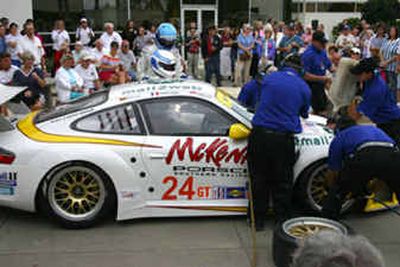NASCAR’s outdated engine specs

Q: Why doesn’t NASCAR get more modern with their engine rules? They run engines with carburetors, and the last I looked, no cars manufactured today use carburetors. They are all fuel-injected. Also, what is your opinion of the restrictor racing and extra cost involved? — Sammy H., e-mail from Florida
A: Sammy, these are good questions and the subject of lots of behind-the-scenes talk. As for carburetors, you are correct: Virtually no cars built today utilize carburetors. Also, the camshafts used in the Nextel Cup cars are the “old style” flat tappet cams, which are neither as efficient nor as durable as roller cams. I’d like to see some change in the future, notably a move to fuel injection and roller cams.
Now, with this said, I want to point out that it is much easier hitting a few keys on a keyboard saying what I’d like to see in the future than actually implementing the changes. However, too many times we’ve heard stories of drivers dropping out of races because of a bad camshaft. The rollers would eliminate these cam concerns, so that would be a great way to at least put the process in motion.
As for the restrictor-plate racing, the cost to do research and development in this area is staggering. Dale Earnhardt Inc. employs six full-time technicians who do only restrictor-plate engine development. Of course, the results speak for themselves, as DEI is the premier restrictor-plate team. Still, to spend literally millions of dollars in search of three or four more horsepower, which is the difference between a checkered flag and a top-10 finish, is very questionable.
I do feel that one of these years, restrictor-plate racing will be a thing of the past and NASCAR will control the speed of the cars in other, less expensive, ways (again, it’s not easy to implement rules like this and please everyone). Most important, however, are the number of teams that can’t compete in this restrictor-plate R&D. The list seems to be growing, while the teams from DEI, Richard Childress, Rick Hendrick and Robert Yates do well.
***
Q: I read recently that the NHRA is the only sanctioning body to allow spectators to access the pits while the crews are working on the cars. What about us sports-car fans? Doesn’t the Sports Car Club of America allow spectators in the pits exactly like the NHRA? — M.M., e-mail from New Jersey
A: Thanks for pointing this out, M.M. Yes, the SCCA does allow spectators into the pit paddock at their Club and Pro events. Phil Clarke, Director of SCCA Club Racing, told us that the SCCA works with all regions hosting events to define parameters of the working paddock area so spectators can wander around and talk to drivers and team members.
Garret Mudd, representing Pro Racing at SCCA, said that at the World Challenge Races, most teams also have hero handout photo cards and posters available for the fans, similar to the NHRA’s way of doing things. Mudd also explained that the paddock in SCCA is the garage area, which is off-limits at many NASCAR events to normal ticket-buying fans.
Additionally, spectators who attend American LeMans Series events are treated to similar hospitalities. ALMS fans have the opportunity to view the cars, drivers and teams in the paddock area, not from a far-away seat through a pair of field glasses. Each ALMS event features a driver autograph session with free hero cards and paddock open house, offering fans of all ages the opportunity to meet their favorite competitors in an informal, personal way. You’ll find the drivers and teams at ALMS and SCCA events happy to oblige and meet as many fans as possible.